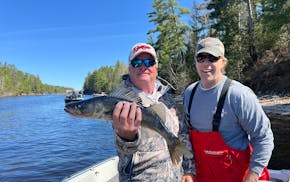If you started a timer now to gauge the days, weeks and months that will pass before the Department of Natural Resources acts to restrict the effects of forward-facing sonar on Minnesota muskie populations, you'll soon have to recalibrate your timepiece to measure in years, and perhaps decades.
Because as history shows, the DNR will take that long and perhaps longer to protect a troubled resource.
As with the emergence in Minnesota generations ago of ATVs for ruffed grouse hunting — the omnipresence of which today compromises a fine and hallowed sporting tradition — the development and relative ubiquity among anglers of forward-facing sonar poses a clear and present danger to a resource and tradition the DNR is obligated to protect: muskies and muskie fishing.
Muskies show up on forward-facing sonar like torpedoes. Actually, to anglers skilled in using this technology — and their numbers are increasing daily — these treasured fish appear on designated display screens more like submarines, with their relative sizes easily distinguishable.
Increasingly, this is what's heard in muskie boats: "That's a small one. Not worth casting to."
Then, an hour or two later, after gadget-ladened anglers patrol a victim lake still further: "There's the one we want. Let's cast to it until it chomps one of our baits."
Left unsaid, meanwhile, is this: "If we don't get a strike, we'll continue to harass this poor fish until we find another one big enough to cast to. Meantime, we'll just drive around the lake, looking at our display screens."
Muskies aren't the only fish that can be picked off with disproportionate ease using forward-facing sonar. Crappies also are vulnerable, as are bass and, yes, walleyes.
Recently, Mississippi fisheries managers lowered crappie limits in some state waters due to higher catch rates by forward-facing-sonar enabled anglers.
Similar crappie protection regulations are needed in Minnesota. But that won't happen for years, if at all, because the mutually beneficial love fest that has long joined at the hip gear manufacturers, the outdoors media and resource brokers otherwise known as fish and game managers won't allow it.
So, saving crappies, bass and walleyes will have to wait for another day. Or year.
Meanwhile, the hear-no-evil, see-no-evil cone of silence that exists among too many muskie anglers about forward-facing sonar is embarrassing.
You can't shoot a deer out of a car window in Minnesota. You can't bait ducks. And you can't use drones to hunt anything.
But too many muskie anglers, expert and non-expert alike (including some guides), think it's OK to hang a whiz-bang transducer over a gunnel or attach it to the shaft of a bow-mounted trolling motor to fast-track the time between bites.
A few years ago, the $2,500 to $4,000 these contraptions cost was believed to be a bridge too far for most anglers. Wrong, according to Mississippi Department of Fish, Wildlife and Parks regional biologist Keith Meals, as reported recently by Richard Simms, editor of CrappieNOW: "We did a three-year study on [lakes] Sardis, Enid and Grenada looking at if they were catching fish with a single pole or trolling," Meals said. "We also looked at if they were using [forward-facing] sonar. In that three-year period, we saw our fishermen using live sonar increase from 20 percent up to 70 percent and it's probably higher than that now."
As a result, as Simms reports, at the suggestion of biologists, the Mississippi Commission on Wildlife, Fisheries and Parks reduced the crappie creel limit on the state's four major crappie lakes. Limits will drop from 15 per day to 10. Also reduced was the daily boat crappie limit to 25 daily, down from 40.
If Minnesota didn't have muskies, and if its muskie population weren't already trending downward on a historical basis, the state's crappies — like those of Mississippi — would be the fish most threatened by forward-facing sonar.
Here's why:
In winter, when Minnesota crappies commonly suspend in schools, anglers traditionally have had difficulty finding them. Multiple holes usually had to be drilled through the ice, into which — before the advent of forward-facing sonar — old-school transducers were lowered to "see" whether crappies were schooled more or less directly beneath each hole.
With forward-facing sonar, far fewer holes are needed. Anglers often need only to auger a handful of icy cylinders before dropping a forward-facing transducer into the water to see whether fish are swimming within a 100-foot radius or so of the holes.
Already, the DNR has studied what can happen to wintertime crappies that are caught in fairly deep water and subsequently released because they're too small. Many die of "barotrauma," or what in people is commonly called decompression trauma, or the bends.
But saving crappies is a cause for another time. Today, muskies are the species most precariously on the hook, as it were. And the use in Minnesota of forward-facing sonar in the pursuit should be illegal.
Would such a regulation be enforceable?
Of course.
Conservation officers can and often do watch anglers from afar, using binoculars or spotting scopes to catch scofflaws.
But it shouldn't have to come to that.
The state's muskie anglers through the years have been among the nation's most ardent and, yes, forward-facing conservationists. At their insistence, a 54-inch muskie keeper restriction was put in place statewide.
Now they should get the tech out of their boats and put the skill back in.

Anderson: In early June, Minnesota fish are begging to be caught. Won't you help?

Anderson: Tails wagging, DNR officers' dogs find lost people and missing evidence
Anderson: Punish poachers more
Anderson: The Chainsaw Sisters Saloon is gone, but the Echo Trail is still a pathway to possibilities


